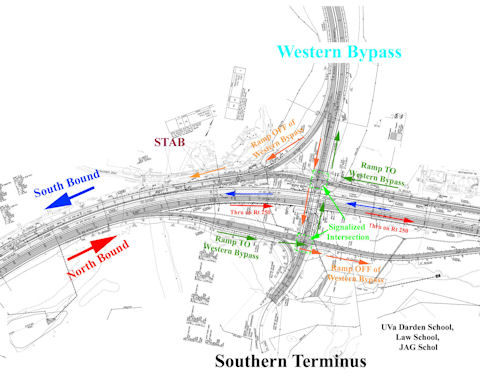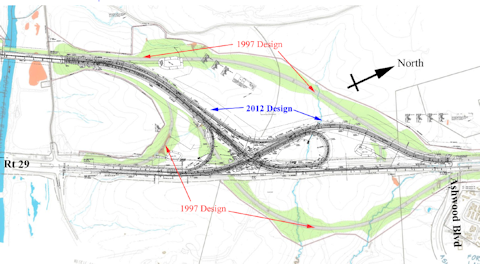About Bacon’s Rebellion
Bacon's Rebellion is Virginia's leading independent portal for news, opinions and analysis about state, regional and local public policy. Read more about us here.
Cheaper, Yes. But How Effective?
Skanska/Branch's new design for the Charlottesville Bypass shaves tens of millions of dollars off construction costs. But will it move traffic as efficiently as the original design?
by James A. Bacon
Foes of the controversial Charlottesville Bypass could well adopt the famous motto of John Paul Jones when his ship, The Bonhomme Richard, was losing the battle with the HMS Serapis: "I have not yet begun to fight!"
Continued opposition to the Bypass might seem futile now that the Virginia Department of Transportation (VDOT) has identified Skanska/Branch Highways as the low bidder for constructing the highway and the Commonwealth Transportation Board has given final approval for the allocation of funds. But Bypass foes are not prepared to concede defeat. Indeed, like Jones, who closed with the Serapis to engage in hand-to-hand combat, Charlottesville area activists are poring over Skanska's conceptual design for the bypass in preparation for a do-or-die public information meeting with VDOT.
VDOT has not yet scheduled a promised event to solicit input from the public, the Federal Highway Administration has not yet completed a review of the Environmental Impact Assessment, and VDOT has not yet formally awarded the contract to Skanska. Indeed, according to an email from Culpeper transportation district chief Jim Utterback to Albemarle County Supervisor Dennis Rooker, VDOT was not expecting to meet with Skanska until late July. "There are a number of contract items and initial steps moving forward to be reviewed and worked out with them."
With the goal of influencing the federal EIA findings, anti-bypass activists are scrutinizing Skanska's roadway design, which seemingly solves several issues that threatened to drive the cost of the project considerably higher than the earlier, $244 million estimate. By reducing the footprint of the southern and northern termini, Skanska's design saves roughly $36 million in right-of-way acquisition costs. Running the highway at a higher elevation over Stillhouse Mountain also cuts excavation and disposal costs.
But will the new design deliver on the promised travel time savings? That would seem to be a central issue, given the justification of the project as necessary to facilitate commerce on what the state has designated a "corridor of statewide significance." The original bypass plans would have supported a 60 mile-per-hour speed limit. Under normal conditions the trip would take roughly six minutes, 30 seconds, shaving about two minutes and 40 seconds from the average length of each trip on the existing stoplight-studded U.S. 29. (See "The Road to Wealth Destruction" to see how the time savings were calculated.)
The new design adds two stoplights and may lower the average travel speed, however, potentially cutting into the hoped-for time savings. Jeff Werner, transportation and land use planner for the Piedmont Environmental Council, has focused on three key areas -- the southern terminus, the elevation over Stillhouse Mountain, and the northern terminus -- for analysis.
 Click here for larger image.
Click here for larger image.
Southern terminus. The interchange requires two new stoplights. Northbound traffic will follow the route indicated by the green arrows: exiting U.S. 250 to the right, halting at a stoplight, turning left, crossing U.S. 250 at an 11.4% grade, encountering another stoplight, and then proceeding onto the bypass.
Southbound traffic will have an unobstructed exit from the bypass onto U.S. 250 heading south, but will encounter the same two stoplights when entering Leonard Sandridge Drive leading tothe University of Virginia or heading east to downtown Charlottesville.
The sequencing of the stoplights has not yet been made public. But assuming average cycle times of one minute each and, optimistically, no major back-up during rush hour, it the lights could add a minute or so to northbound trips and some southbound trips.
Stillhouse Mountain. One of the great challenges designing the bypass is crossing Stillhouse Mountain located near the southern terminus. The original plan called for massive rock excavacation and removal in order to keep the grade moderate. Skanska's engineering solution will reduce excavcation and removal costs by elevating the highway. The incline will be very steep, says Werner.
Roughly one in ten vehicles using the bypass is expected to be a truck. If northbound trucks start from a full stop at the second stoplight, they will labor for hundreds of yards up a steep incline to reach a posted 60 miles-per-hour speed limit. This design change has the potential to add significant travel time for tractor-trailers and the cars caught behind them.
Northern terminus. Skanska/Branch was working under two major constraints when designing the northern terminus. First, to save costs, it had to shrink right-of-way acquisition and eliminate an expensive flyover over the highway. Second, to please nearby residents, it had to avoid using stoplights. The design solution, creating a tight loop between northbound and southbound lanes was very clever, says Werner. However, it may not move traffic as efficiently as the original, more expensive VDOT design.
One source of concern is that vehicles traveling north on U.S. 29 but want to go south on the bypass (to the left on the map above, which has been rotated to fit a horizontal format) will have to complete a tight fish hook configuration that will restrict speed limits to much below 60 miles per hour.
Another issue, says Werner, focuses on where the bypass will join U.S. 29 just south of Ashwood Boulevard. VDOT’s initial concept for a grade-separated interchange at the north end of the bypass provided for three lanes of travel but Skanska's plan shows only two lanes. The Commonwealth Transportation Board has funded a widening of U.S. 29 north of Ashbrook in its Six Year Improvement Program. The work is sceduled to begin in Fiscal 2015. If the Bypass opens before the widening is finished, the configuration could create a major bottleneck -- at least for a time.
More than a week before publication of this article, Bacon's Rebellion asked to interview someone on the VDOT staff who could comment upon the Skanska/Branch design changes. Due to holidays and weather-related events, said VDOT spokesman Lou Hatter, the department was unable to locate anyone. Skanska/Branch did not respond to a Bacon's Rebellion request for an interview.
If VDOT has analyzed the impact of the design changes on traffic patterns and average travel times, it has not made them public yet. While it appears unlikely that Skanska's tradeoffs will eliminate the full two-minute, 40-second average time saved from using the bypass, the changes could diminish time savings by a measurable amount. Bypass foes will have an opportunity to dig into the details when VDOT schedules its information session. The chances of last-minute revelations persuading federal highway authorities to pull their support for the project seem remote. But, then, the English captain of the Serapis never imagined that he'd end up losing his ship to John Paul Jones.
This article was written under a sponsorship by the Piedmont Environmental Council.


